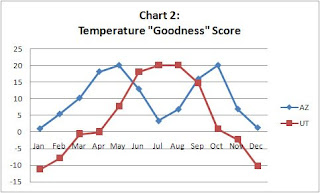122 to 49: AZ wins!
The horrible summer temperatures are starting to ease here in AZ, and going outside is no longer feels like you're a Big Mac under a heat lamp. Before I moved here, I imagined AZ as a year round death valley, with withering temperatures and never any rain.
Well, it turns out that it does rain, and hard. And it turns out that the temperatures here are wonderful most of the time. Let me prove it to you.
We moved here from a cooler climate, where there really isn't the baking heat in the summer. There is, however, a long horrible freezing winter. Which climate is "better", you ask? Lets look at that question.
How do you measure "goodness" of climate? There are a lot of factors: wind, storms, snow, rain, temperature, humidity, and so forth.
Because AZ gets such a bad rap for the heat, let me focus purely on temperature. My ideal temperature range is 65-85 degrees Fahrenheit. Colder or hotter than that is less than ideal. I like it warm during the day and cool at night. (This corresponds well to UT in July and August, and AZ in May and October. It also corresponds to Maui pretty much all year.) You may have a different "ideal" range, but let's use my range for the purposes of this discussion. For me, anything over 100 degrees, or under 32 degrees is unacceptable and very uncomfortable. This is the "horrible" range. These ranges will form boundaries for grading the temperatures in UT and AZ.
Using the magic of the internet, I was able to find the average high and low temperatures for both where I live in AZ and where I used to live in UT. These numbers are the average highs and lows for the last 20 or so years, so any individual year will vary from these numbers.
Now, to measure the "goodness' of the temperatures. I decided that any time the average temperature range for a state moves into the ideal range, it will earn points for how much of the range is covered. The parts of the monthly temps that are outside the ideal range get no points. When the monthly temps enter the horrible range they get negative points. The points received equal the area of the temperature range within the ideal or horrible ranges. The most points that a month can earn is 20, as the ideal range covers 20 degrees. This means that the best possible yearly score that could be given to an area is 240.
Some examples, if the average monthly temperature range is 65-85 degrees, it matches exactly to the ideal range, and will receive a full 20 points for that month. If the temp range was 45-75, it covers 10 degrees of the ideal range, and would only receive 10 of the possible 20 points. If the range was 90-100, it would receive 0 points for that month. If the range was 100-110, it covers 10 degrees of the horrible range and would be given a score of -10. Note that a monthly temp range could include part of the ideal range and part of the horrible range.
So, what's the final score? AZ gets 122 weather goodness points, and UT gets a meager 49. This just means that most of the time the temperatures in AZ are closer to my ideal than UT.
 Chart 4 shows those results. The results? Even with those preferred temperature ranges, AZ wins with 107, HI is second with 103, WA achieves an 89, and UT falls to last with 74. One sign that this "ideal" temperature range is wrong? Any test that says that Maui doesn't have the best weather is messed up. Maui is perfect.
Chart 4 shows those results. The results? Even with those preferred temperature ranges, AZ wins with 107, HI is second with 103, WA achieves an 89, and UT falls to last with 74. One sign that this "ideal" temperature range is wrong? Any test that says that Maui doesn't have the best weather is messed up. Maui is perfect.
All I'm trying to say with this post is that AZ has really wonderful weather most of the year. Don't be hatin' just cuz you don't understand.
2 comments:
I totally agree. A freezing winter in UT is much worse than a hot summer in AZ. That's just one of the reasons making the move makes a whole lot of sense to me! Also, you never have to shovel sunshine. Thanks for doing the detailed analysis. I think you should add Southern California to your chart. The weather is great there, but that's why all the crazy people moved there and the normal people had to move to Utah. : )
You lost me midway through statistic and graphs and charts were never my thing. You did however convince me enough to come back for another visit at the end of next month!
Post a Comment